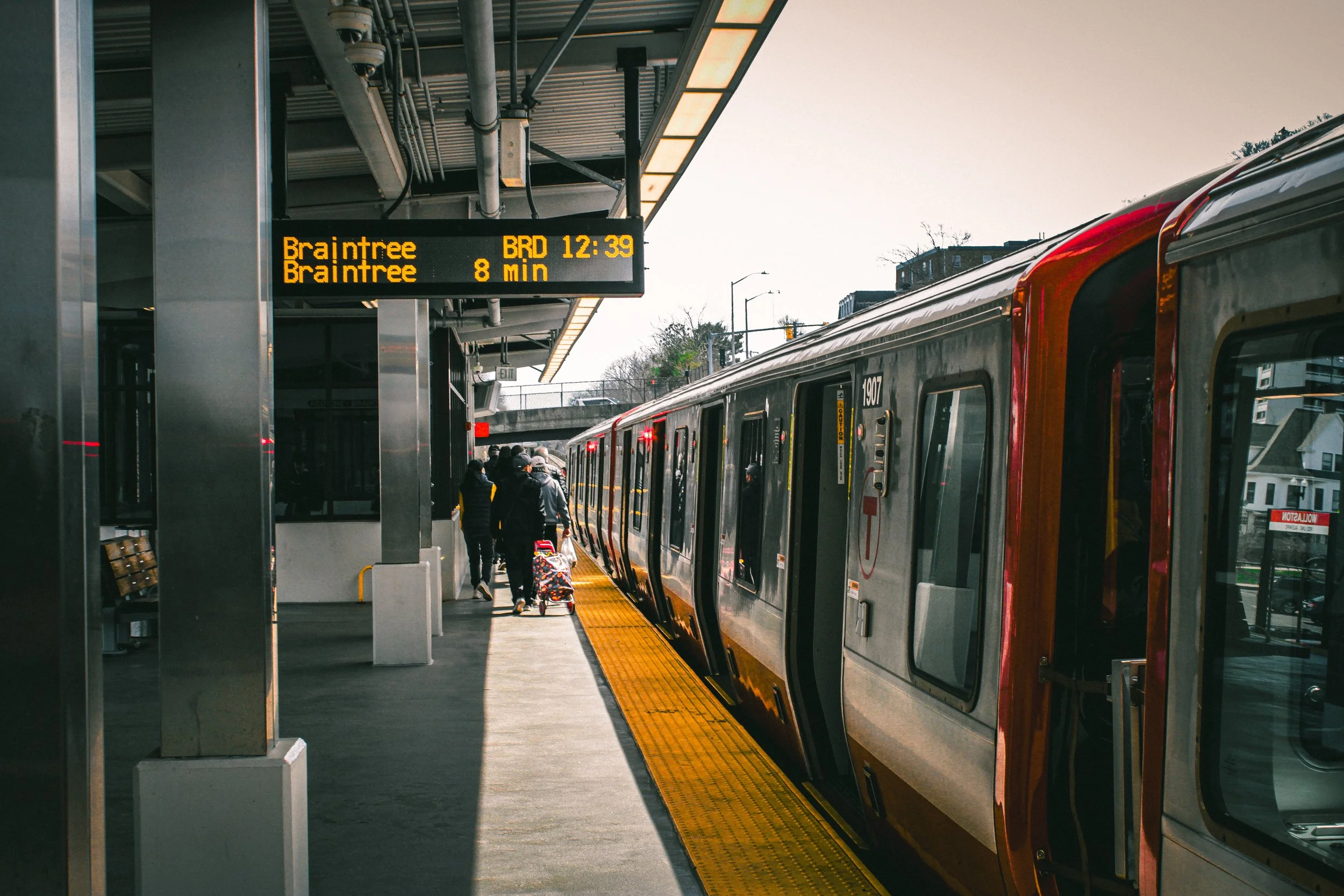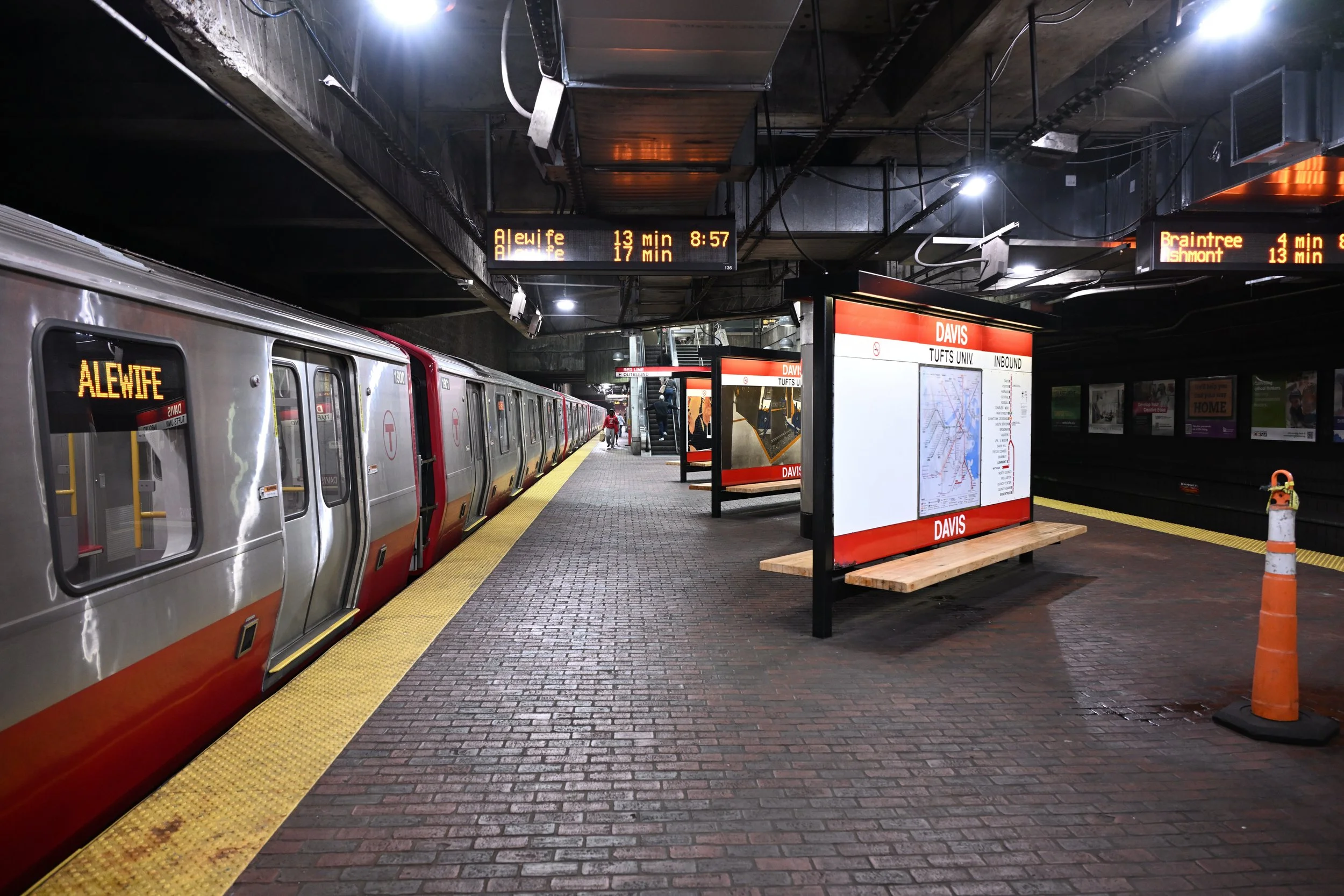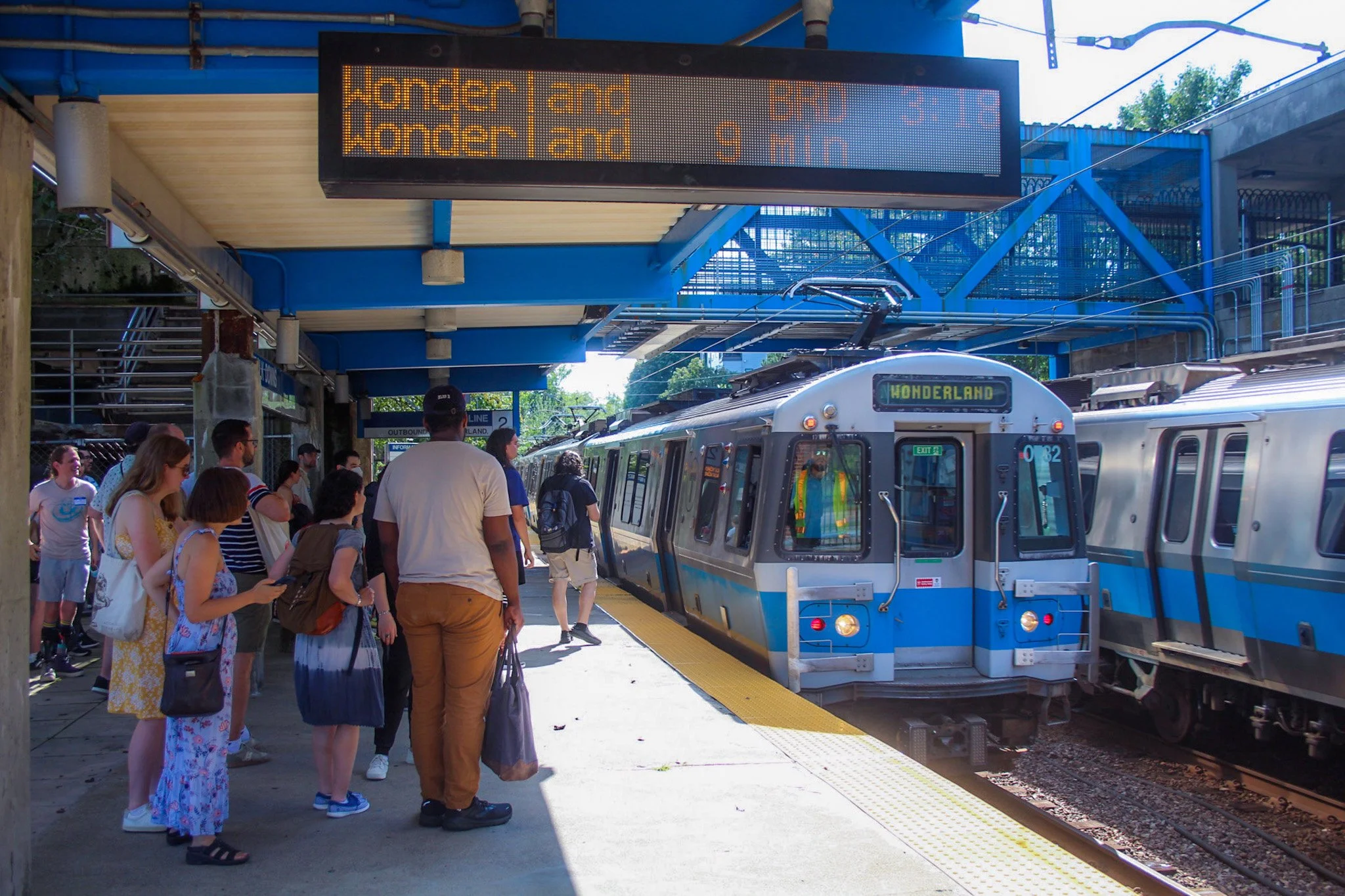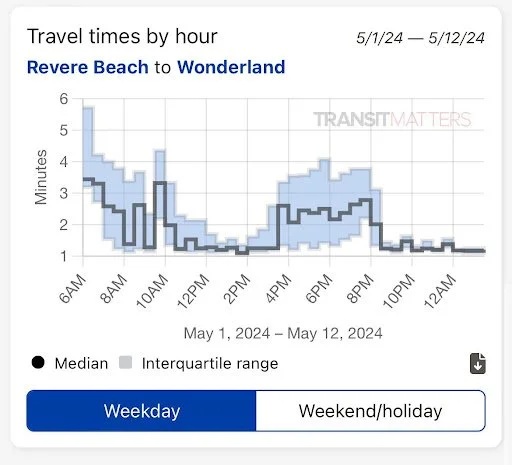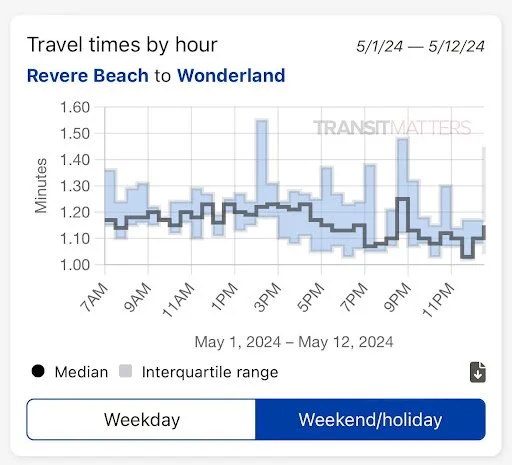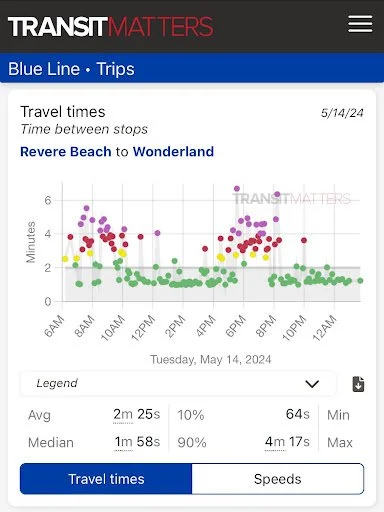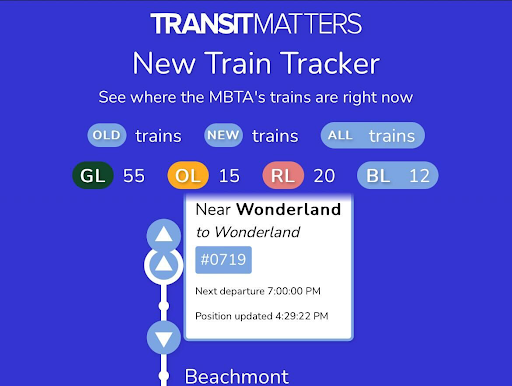
TransitMatters Analysis: South Shore, Slow no more
Even with the few slow zones that still remain on the Red Line today, this work marks a monumental point in the T’s efforts to eliminate slow zones across the network and fortify transit across the region.
BOSTON, October 9, 2024 — On September 6, 2024, the MBTA began a 24-day shutdown on the Red Line Braintree Branch, suspending service between JFK/UMass and Braintree to complete critical trackwork.
On September 30, 2024, the MBTA claimed it removed 37 speed restrictions across 18 miles of track, improving round-trip Braintree Branch travel times by 24 minutes. And based on our analysis, the agency did exactly that!
Here are the big takeaways from the shutdown:
The T delivered! The Red Line Braintree Branch is slow zone-free, and the entire Red Line is nearly slow zone-free.
This resulted in a time saving of nearly half an hour round-trip for riders.
PRE-SHUTDOWN
In January 2021 (the last month that the Red Line had no slow zones), the average travel time northbound between JFK/UMass and Braintree was 19 minutes and 25 seconds and 21 minutes and 22 seconds southbound.
By the end of August 2024—a week before the shutdown—the average travel time northbound between JFK/UMass and Braintree was 33 minutes and 41 seconds and 31 minutes and 27 seconds southbound.
POST-SHUTDOWN
A week following the shutdown, the average northbound travel time between JFK/UMass and Braintree was 18 minutes and 5 seconds and 19 minutes and 3 seconds southbound for over 27 minutes of saved round-trip travel time, as the T promised. Our Slow Zone Tracker also shows that the T removed all slow zones on the Braintree Branch.
This shutdown, a critical part of the Track Improvement Plan (TIP), was vital to improving service and reliability for the thousands of riders the Red Line sees weekly. Along with the trackwork, the T made essential station repairs and improvements, including repairs to the pedestrian overpass and roof at JFK/UMass Station.
Riders impacted by this shutdown were among the hardest hit, overwhelming alternative Commuter Rail and shuttle service capacity. However, following this shutdown, the MBTA hopes to see Red Line speeds return to 40 mph and potentially increase to 50 mph.
Still, a couple of slow zones remain today. In both directions, between JFK/UMass and Andrew, riders see 46 to 69 seconds of delay. Southbound from Central to Kendall/MIT, riders are seeing 28 seconds of delay. The T will address these remaining slow zones in brief shutdowns in November.
Two remaining Red Line shutdowns planned for this year will hopefully remove the final three slow zones on the Red Line.
November 5–10: Broadway to North Quincy
November 18–24: Harvard to Broadway
Even with the few slow zones that still remain on the Red Line today, this work marks a monumental point in the T’s efforts to eliminate slow zones across the network and fortify transit across the region.
To keep up with all things MBTA shutdowns, please visit mbtashutdowns.info.
Photo credit: Brooke Winter
TransitMatters Analysis: A Cause for Celebration as Red Line Slow Zones are Removed, Students Rejoice
Compared to early July, there are 3.6-minute savings northbound and 77-second savings northbound, bringing travel times back in line with pre-COVID averages.
Boston, August 19, 2024 — On June 18, the MBTA announced that it would shut down sections of the Red Line throughout July for the following days:
Between Alewife and Kendall on the evening of July 12 and during July 15–26
Between Alewife and JFK/UMass, the weekends of July 13–14 and July 27–28
Between Alewife and Park Street during the weekend of July 20–21 and the evenings of July 15–26
On July 30, the MBTA announced the shutdown's successful conclusion. The T removed nine speed restrictions, two more than initially planned, among other improvements.
Here are the big takeaways from the shutdown:
The T fixed nearly all track-related slow zones between Alewife and Kendall/MIT, resulting in almost five minutes of travel time savings (nearly in line with pre-COVID travel times)
The T’s extension of the shutdown to Park Street and JFK/UMass on weekends didn’t produce travel time savings for riders, but it did allow the T to remove five miles of scrap rail from the right of way as it had intended.
The semester speeds ahead
Removing the notorious slow zones between Harvard and Kendall/MIT will be a significant relief for students. Late last year, The Harvard Crimson published an op-ed describing a student's 38-minute commute from Alewife to Park Street. Luckily for this student, since the publication of this article, the average commute between those two stops has dropped by nearly 12 minutes, a 40% decrease. The latest shutdown, just in time for the fall semester, contributed around five minutes to the decline.
PRE-SHUTDOWN
In January 2021 (the last month that the Red Line had no slow zones), the average travel time northbound between Alewife and Kendall/MIT was 14 minutes and 14 seconds and 12 minutes and 58 seconds southbound.
By July 2024, the average travel time northbound between Alewife and Kendall/MIT was 17 minutes and 27 seconds and 15 minutes and 5 seconds southbound.
POST-SHUTDOWN
In the weeks following the shutdown, the average travel time northbound between Alewife and Kendall/MIT was 13 minutes and 39 seconds and 13 minutes and 48 seconds southbound - a savings of 4.8 minutes of travel time between Alewife and Kendall/MIT.
Compared to early July, there are 3.6-minute savings northbound and 77-second savings northbound, bringing travel times back in line with pre-COVID averages. Woohoo!
Riders may wonder why their trip through downtown has not yet improved despite the shutdown extending to Park Street or JFK/UMass on weekends and evenings. However, the MBTA announced that this extension allowed materials to be brought in and scrap rail removed rather than to fix additional slow zones.
Other closures under the Track Improvement Plan have maximized the efficiency of shutdowns by making additional improvements to stations as well. The T welcomed back Red Line riders with cleaner and fresher stations, some of which have received retiling, a powerwash, new lighting, and more.
The T still has some work to do. One slow zone, which slows riders down by half a minute, remains between Central and Kendall/MIT, as well as a group of slow zones between Kendall and Park Street. An additional Red Line shutdown is scheduled between Kendall/MIT and JFK/UMass between August 19 and 25.
This shutdown was originally scheduled for October but was moved to accommodate the academic calendar. The bulk of the slow time on the Red Line remains between JFK/UMass and Braintree. The MBTA plans to address these Braintree branch slow zones with a 24-day shutdown between September 6 and 29.
To keep up with all things MBTA shutdowns, please visit mbtashutdowns.info.
###
Photo Credit: James Wang
TransitMatters Analysis: Blue Line Speeds up post-shutdown; operations hurdles remain
The T fixed track-related slow zones on the Blue Line, resulting in 3 minutes of travel time savings (although still 2 minutes slower than February 2023). The T also suffers from operational issues at Wonderland during peak periods, hampering performance.
BOSTON, May 17, 2024 — On March 15, the MBTA announced that it would shut down sections of the Blue Line throughout April for the following dates:
Between Maverick and Wonderland from April 17 to 21
Between Airport and Wonderland from April 22 to April 28 (though this ended up being extended to April 30)
Plagued with slow zones and catenary wire system troubles, the Blue Line desperately needed some TLC.
“For the first time in more than a year, the MBTA has less than 100 speed restrictions across the entire system.”
On May 1, the MBTA announced the successful conclusion of the shutdown, marking a significant milestone of less than 100 speed restrictions across the entire system. This achievement resulted from removing 19 speed restrictions on the Blue Line, among numerous other improvements. The MBTA claimed that riders regained “over three minutes of travel time” on the Blue Line.
We've come to two conclusions from the data over the past few weeks:
The T fixed track-related slow zones on the Blue Line, resulting in 3 minutes of travel time savings (although still 2 minutes slower than February 2023).
The T suffers from operational issues at Wonderland during peak periods, hampering performance.
Slow zones no more
Before the Blue Line shutdown, we tracked seven slow zones. Most were concentrated between Orient Heights and the Airport. At their peak, these slow zones added over three and a half minutes to a roundtrip ride. Let's take a look at the numbers before and after the shutdown.
PRE-SHUTDOWN
In February 2023 (the last month that the Blue Line had no slow zones), the average travel time northbound between Revere Beach and Bowdoin was 17 minutes and 21 seconds and 17 minutes and 21 seconds southbound.
By April 2024, the average travel time reached 21 minutes and 7 seconds northbound and 19 minutes and 39 seconds southbound, a substantial increase.
POST-SHUTDOWN
In the week following the shutdown, the average travel time northbound between Revere Beach and Bowdoin was 18 minutes and 26 seconds and 18 minutes and 38 seconds southbound.
The T saves three minutes of travel time from Revere Beach to Bowdoin. Compared to April, there is a one-minute time savings southbound and a two-minute time savings northbound. However, travel times are roughly a minute longer than they were in February 2023, suggesting there is still some ground to be regained.
If we look at the travel times between Revere Beach and Wonderland, some interesting questions about terminal operations arise. During peak times, weekday travel times can average close to four minutes. We do not see the same issue on weekends or off-peak periods.
So what does this all mean?
From Revere Beach to Wonderland, the track conditions allow the T to operate at full speed, which they do at off-peak times. However, during peak periods, the T struggles to turn trains at pre-COVID service levels, resulting in trains being stopped and delayed for up to 3-4 minutes due to a switch issue, a signal issue, or a more significant ops issue altogether.
Two TransitMatters volunteers took the trek to Wonderland to see if the data was telling the truth. We noticed a few instances of trains sticking around for a couple of minutes after dropping passengers off, causing any trains behind them (such as #0719 shown below) to be delayed. We’re unable to know for sure why these delays are occurring, but we do know they’re adding precious minutes to outbound trips.
Until these issues are solved, the T will have difficulty increasing service levels at peak times, even with ideal track conditions.
If the MBTA fulfills its promise to eliminate all slow zones from the system by the end of 2024, the Legislature and the MBTA will still have work to do and investments to make in the system to get riders where they need to go quickly.
Visualize the data with our Data Dashboard.
Here is an overview of the southbound line from the beginning of the year.
Here is that same overview for the northbound line.
For media inquiries, please email media@transitmatters.org.
###
Photo Credit: Jacklyn Thibodeau
Categories
- Children (1)
- Diversions (1)
- Olympics (1)
- MAPC (2)
- Red–Blue Connector (2)
- Urban Design (3)
- Bus (4)
- Fares (4)
- Late Night Service (4)
- MBTA ROC (4)
- Silver Line (4)
- Snow (5)
- Blue Line (8)
- Emergency (8)
- Orange Line (8)
- Public Comment (8)
- Maintenance (9)
- Operations (9)
- Signage (9)
- Fare Collection (10)
- Labs (11)
- Safety (11)
- Planning (12)
- Communication (14)
- MBCR (14)
- MassDOT (14)
- Green Line (16)
- History & Culture (16)
- Red Line (18)
- MBTA Bus (21)
- Commuter Rail (24)
- Advocacy (26)
- Capital Construction (28)
- Politics (30)
- Podcast (35)
- News (38)
- Media (40)
- Funding (42)
- Statements (50)
- MBTA (57)

